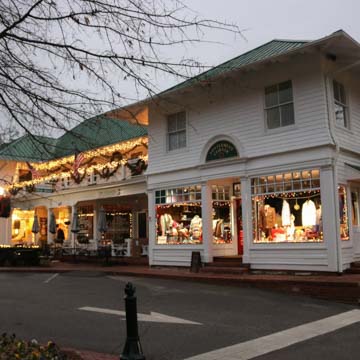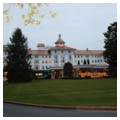You are here
Village of Pinehurst
Pinehurst Village forms part of the larger history of American resort towns and utopian retreats. In the late nineteenth century, mass industrialization created unprecedented wealth but people became increasingly weary of the rapid and drastic changes to the urban environment. They felt something essential was being lost, and this nostalgia became a driving force behind middle- and upper-class residents retreating to secluded villages in the countryside for vacation. James W. Tufts, a Boston entrepreneur and inventor of the soda fountain, conceived of Pinehurst as a winter retreat for middle-class northerners. Initially, Tufts intended Pinehurst to be a healthful retreat, a place with clean air and crystal water, where ailing northerners could retreat from the vile pollution of industrial urbanity to nurse their bodies and “delicate lungs” to better health. However, when Tufts realized tuberculosis was highly contagious, he quickly changed plans to market it as a recreational rather than a health resort.
In June 1895, Tufts bought 4,703 acres of land in the Sand Hills region of North Carolina. At the time, the locals were perplexed and his peers thought him a fool because neither group found the land particularly beautiful or productive. The sandy soils held little water or nutrients, resulting in vast pine barrens that had, for decades, been overexploited by the turpentine and tar industries. Tufts was not distracted by its current state but enchanted by the crisp balsamic scent, clean water, and mild winters. He commissioned Frederick Law Olmsted’s firm to design his resort village. This was one of only two Olmsted projects in North Carolina; the other, the Biltmore Estate near Asheville, was also designed for a wealthy northerner. Olmsted was late in life by the time he arrived at Pinehurst, and quickly succumbed to dementia. Much of the work was done by his assistant, Warren Manning, whom Tufts kept on after Manning left Olmsted to establish his own office. Pinehurst is therefore a blend of the Olmsted’s pastoral and Manning’s horticultural approaches.
Olmsted’s legacy is most evident in the formal layout, which borrows heavily from his suburban village project at Riverside, just west of Chicago. The 110-acre village centers on an oval-shaped green, with the Holly Inn at its head and cottages for guests along its sides. A small commercial district, modeled after those in New England villages, extends westward from the Holly Inn and originally included little more than a general store and a casino that served as something of a social center for the community.
Along picturesque roads that radiate out from the Village Green, Manning’s horticultural expertise is noticeable in the heavy plantings that separate pedestrian walkways from street traffic and provide privacy for the Colonial Revival and Queen Anne cottages. To keep costs down, Manning used mostly native plants, bringing in only the deodar cedar and nandina plants. He established a nursery on the property to ensure the quality of plant stock; this nursery later became famous for introducing native North Carolina plants throughout the nation.
Much of the village architecture was completed under the direction of the Boston firm Taylor, Kendall and Stevens. The Holly Inn continues the colonial New England theme: it is a two-story, wood-frame structure with dormer windows in the deep gable roof. Large, cross-gable projections on either end balance a gently protruding double-height entrance bay with a classical pediment. The classical reference is not original; the entrance bay used to be a center block topped with a belfry. The Holly Inn welcomed twenty guests for the first time on December 31, 1895, after a miraculously quick nine-month construction. The forty-five rooms were luxuriously appointed with steam heat and electricity; a solarium and telephone service were also available to guests.
The Holly Inn was Pinehurst’s premier short-term lodging until the Carolina Hotel was built just five years later in 1900. “The Queen of the South,” as it was called, was designed in an H-configuration with large traverse end wings to provide abundant sunshine and fresh air for every room, much in accordance with the town’s founding principles as a healthful retreat. The four-story, wood-frame structure extends out from a five-story central pavilion with four-story bay windows running up the facade and capped by an octagonal cupola.
When forced to reconsider the fiscal health of his resort, Tufts looked for ways to ensure its attraction. He had noticed other health resorts were severely lacking in recreational facilities, and that many of his guests brought with them golf clubs to play renegade games in the surrounding fields. The Pinehurst Resort opened its first golf course here in 1897, just nine years after golf was introduced to the United States, and the resort quickly became a famous destination for the sport. The most famous course is Pinehurst No. 2, designed by Donald Ross, which opened in 1907.
Although Tufts’s initial vision for the resort was to be “eminently adapted to the benefit of invalids,” with its focus on recreation, particularly golf, it became geared toward a higher-income clientele. As demand increased, Tufts had little problem requiring guests to present written recommendations from one’s physician and minister attesting to their physical health and moral character. Pinehurst was well on its way to being an exclusive colony for wealthy northerners, its fate secured when his son inherited the property and turned it into a corporate operation. Pinehurst remained in the control of the Tufts family until January 1971, when it was sold to Diamondhead Corporation. In 1980, the Village of Pinehurst became an incorporated municipality.
Pinehurst was designated a National Historic Landmark in 1996. It remains a recreational destination, particularly the golf resort, which is host to many major golf championships.
References
Hood, Davyd Foard, and Laura A. W. Phillips, “Pinehurst Historic District,” Moore County, North Carolina. National Historic Landmark Nomination Form, 1995. National Park Service, U.S. Department of the Interior, Washington, D.C.
Hunter, Mary Elle. A Place Called Pinehurst. Pinehurst, NC: Printed by author, 1993.
Moriarty, Audrey. Pinehurst: Golf, History, and the Good Life. Ann Arbor, MI: Sport Media Group, 2005.
Moss, Richard J. Eden in the Pines: A History of Pinehurst Village. Southern Pines, NC: The Pilot, 2005.
Pace, Lee. The Spirit of Pinehurst. Pinehurst, NC: Pinehurst, LLC, 2004.
Village of Pinehurst: an Historic Walking Tour. Southern Pines, NC: Convention and Visitors Bureau, 2009.
Writing Credits
If SAH Archipedia has been useful to you, please consider supporting it.
SAH Archipedia tells the story of the United States through its buildings, landscapes, and cities. This freely available resource empowers the public with authoritative knowledge that deepens their understanding and appreciation of the built environment. But the Society of Architectural Historians, which created SAH Archipedia with University of Virginia Press, needs your support to maintain the high-caliber research, writing, photography, cartography, editing, design, and programming that make SAH Archipedia a trusted online resource available to all who value the history of place, heritage tourism, and learning.






